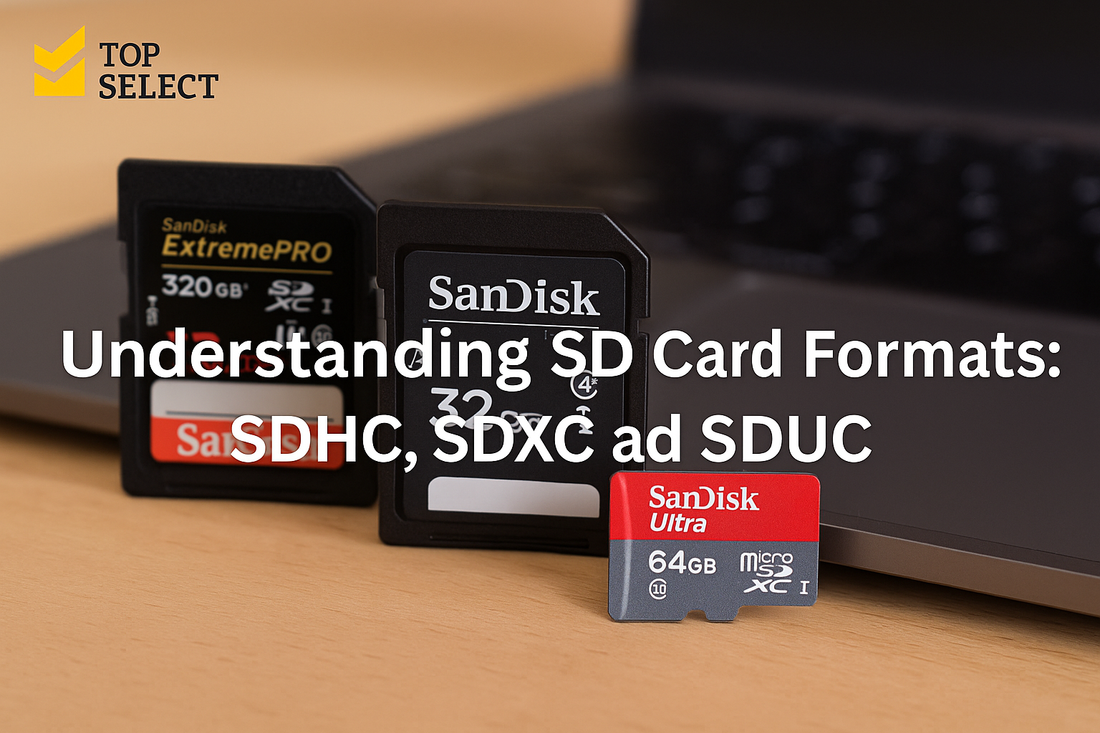
Understanding SD Card Formats: SDHC, SDXC, and SDUC Explained
Share
What Are SD Card Formats and Why Do They Matter?
The term SD card refers to Secure Digital cards, a global storage standard used in cameras, drones, smartphones, laptops, and gaming consoles. But not all SD cards are the same. Formats like SDHC, SDXC, and SDUC define how much data the card can hold, which file system it uses, and whether your device will even recognize it.
If you insert the wrong type of card into your camera or console, it might not work at all — which is why understanding formats is essential before you buy.
Quick Buyer’s Checklist: Choosing the Right SD Card Format
| Step | What to Check | Recommended Choice |
|---|---|---|
| 1. Device Compatibility | Does your camera/console/phone support SDHC, SDXC, or SDUC? | Most modern devices (2010+) → SDXC; Legacy devices → SDHC |
| 2. Storage Needs | How much capacity do you actually need? | Casual use → 16–32GB (SDHC); 4K/RAW workflows → 128–512GB (SDXC); Future 8K/enterprise → 2TB+ (SDUC) |
| 3. File System Limitations | Does your workflow require >4GB file sizes? | Yes → SDXC/SDUC (exFAT); No → SDHC (FAT32) is fine |
| 4. Speed Ratings | Are you shooting 4K/8K video or burst RAW? | Look for UHS-I/II + U3/V30/V60/V90 depending on use case |
| 5. Reliability | Will you use it in drones, dash cams, or extreme environments? | Choose High Endurance or ruggedized models |
| 6. Authenticity | Where are you buying from? | Buy from authorized Canadian retailers like TopSelect to avoid counterfeits & keep warranty |
SDHC: Secure Digital High Capacity
- Capacity Range: 2GB to 32GB
- File System: FAT32
- Compatibility: Widely supported by devices made from ~2006 to 2014.
When to Use SDHC
- Great for basic photography, Full HD video, or older devices that don’t support higher capacities.
- Still useful in point-and-shoot cameras, GPS units, car stereos, and some older laptops.
⚠️ Limitations: FAT32 cannot store single files larger than 4GB, making SDHC cards unsuitable for modern 4K/8K video workflows.
SDXC: Secure Digital Extended Capacity
- Capacity Range: 64GB to 2TB
- File System: exFAT (better suited for large files)
- Compatibility: Standard for most modern devices (2010 and newer).
When to Use SDXC
- Ideal for DSLRs, mirrorless cameras, drones, GoPros, Nintendo Switch, and Android phones.
- Perfect for 4K video recording, RAW photography, gaming libraries, and large app files.
✅ Why It’s the Current Standard: exFAT supports files larger than 4GB, making SDXC the go-to format for video production and high-capacity use cases.
SDUC: Secure Digital Ultra Capacity
- Capacity Range: 2TB to 128TB
- File System: exFAT
- Compatibility: Emerging standard, not yet widely adopted.
When to Use SDUC
- Designed for next-generation devices handling 8K/16K video, VR/AR content, scientific imaging, and enterprise storage.
- Not yet mainstream, but will become critical for professionals working with ultra-high-resolution video and massive data sets.
⚡ Future Outlook: Expect SDUC cards to roll out in professional cameras, servers, and enterprise systems over the next 3–5 years.
How to Choose the Right SD Card Format
To select the best SD card for your needs, consider the following:
- Check Your Device Specs
-
- If your device manual says SDHC only, don’t try an SDXC card — it won’t work.
- Modern devices almost always support SDXC, and some are starting to list SDUC support.
- Match Capacity to Use Case
-
- 32GB or less → Fine for older gear and casual use (SDHC).
- 64GB – 1TB → Best balance of price and performance for 4K video, drones, and modern cameras (SDXC).
- 2TB+ → Niche professional workflows (SDUC).
- Don’t Forget Speed Class
-
- The format (SDHC/SDXC/SDUC) tells you max storage.
- The speed class (UHS, V30, V60, V90) tells you if it’s good enough for 4K/8K video or burst photography.
- Example: A 128GB SDXC card with V90 is far better for video than a basic 128GB SDXC with only C10.
- Buy From Trusted Sources
-
- Counterfeit SD cards are common, especially in higher capacities.
- Always buy from authorized Canadian retailers like TopSelect to guarantee authenticity and warranty.
Quick Comparison: SDHC vs SDXC vs SDUC
| Format | Capacity Range | File System | Device Compatibility | Best For |
|---|---|---|---|---|
| SDHC | 2GB – 32GB | FAT32 | Older devices (2006–2014) | Basic storage, casual photography, GPS |
| SDXC | 64GB – 2TB | exFAT | Most modern devices (2010+) | 4K video, RAW photography, gaming |
| SDUC | 2TB – 128TB | exFAT | Future devices (pro & enterprise) | 8K/16K video, VR, scientific imaging |
Key Takeaway
- SDHC = Legacy format (2–32GB, FAT32).
- SDXC = Today’s standard (64GB–2TB, exFAT, best for 4K video & modern devices).
- SDUC = Tomorrow’s format (2–128TB, for ultra-high-capacity pro workflows).
If you’re shopping in 2025, SDXC is the sweet spot for most users, while SDUC will matter for professionals in the near future.
At TopSelect.ca, we offer a wide range of SanDisk SD cards to meet every need. Explore our collection today and find the perfect storage solution for your device!
Recommended Cards by Format & Use Case
| Format | Best For | Recommended SanDisk Cards | Shop Link |
|---|---|---|---|
| SDHC (2–32GB) | Older cameras, GPS units, basic storage |
SanDisk Ultra SDHC
|
Shop SanDisk Ultra SDHC |
| SDXC (64GB–2TB) | 4K video, RAW photography, drones, Nintendo Switch | SanDisk Extreme SDXC / SanDisk Extreme microSDXC | Shop SanDisk Extreme SDXC |
| SDXC High Endurance | Dash cams, security cameras, continuous recording | SanDisk High Endurance microSDXC | Shop High Endurance microSD |
| SDXC Professional | 4K/8K workflows, burst RAW shooting | SanDisk Extreme PRO SDXC (UHS-I/UHS-II) | Shop SanDisk Extreme PRO |
| SDUC (2TB–128TB) | Future enterprise, 8K/16K video, VR/AR content | SanDisk SDUC (emerging standard) | Contact Us for Availability |
FAQs — SDHC vs SDXC vs SDUC
1) What’s the main difference between SDHC, SDXC, and SDUC?
- Capacity and file system. SDHC = 2–32GB (FAT32), SDXC = 64GB–2TB (exFAT), SDUC = 2–128TB (exFAT, emerging).
2) Can an SDXC card work in an SDHC-only device?
- Generally no. Devices limited to SDHC typically won’t recognize SDXC. Check your device manual.
3) Do I need to format a new SDXC/SDUC card before use?
- Often yes. For best results, format in the device (camera/console/drone) so it applies the correct file system and allocation settings.
4) What file system do these formats use and why does it matter?
- SDHC uses FAT32 (simple, but 4GB single-file limit). SDXC/SDUC use exFAT, which supports files >4GB—important for 4K/8K video and long clips.
5) Which format is best for 4K/8K video work?
- SDXC (64GB–2TB) with U3/V30+ speed class is the current standard. For high‑bitrate 4K/8K or All‑I codecs, consider V60/V90 (often UHS‑II).
6) What’s the difference between UHS‑I and UHS‑II?
- UHS‑II adds a second row of pins for higher bus speeds. You can use a UHS‑II card in UHS‑I gear, but it will run at UHS‑I speeds.
7) Will an SDUC card work in my current camera?
- Only if the camera explicitly supports SDUC. Most consumer devices today support SDXC; SDUC support is still rolling out.
8) Can I use a microSD card with an adapter in SD slots?
- Yes. A quality microSD‑to‑SD adapter works well, but for pro cameras a native SD card can offer more consistent performance.
9) How do I choose capacity?
- Casual/legacy use: 16–32GB (SDHC)
- Modern 4K/RAW: 128–512GB (SDXC)
- Ultra‑high‑capacity workflows: 2TB+ (SDUC) when supported
10) How can I avoid counterfeit high‑capacity cards?
- Buy from authorized retailers, verify labeling/packaging, and run a speed test (e.g., CrystalDiskMark/Blackmagic) to confirm performance.
